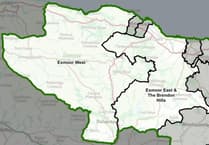EXMOOR can be a bleak place in the winter, but if you know where to look, there are still birds to be found. All the summer visitors have long departed, leaving the resident birds and a few winter visitors.
Among the most noticeable of these visitors are the winter thrushes, Redwings and Fieldfares. These move around in noisy flocks, seeking winter berries as their main form of sustenance to help them through the winter.
If berries are in short supply, they may come into your garden. The numbers of wildfowl and waders build up, too, as the winter progresses. Ducks such as Wigeon and Teal, not encountered at other times of the year, can be found at places such as Dunster Beach and Porlock Marsh.
Waders such as Curlews with their long curved beaks, dramatic black-and-white Oystercatchers and the smaller Dunlins sometimes form big flocks here. Large gull flocks can be encountered in fields or on the coast usually comprising Black-headed, Herring or Common Gulls.
Occasionally the rarer Mediterranean Gull turns up with its all-white wings. A returning long-staying one, now for its 17th winter, can be found wintering around West Quay.
At Wimbleball Lake, Goosanders usually appear in October and stay until March. The female has a conspicuous chestnut crest, while the male’s head is dark green. These birds are best looked for at dawn or dusk, when they leave or arrive at their favourite roosting spots near the dam.
The woodlands can be quiet at this time of year, but it is worth persevering as sooner or later you may find a winter flock of birds, sometimes composed of different species.
It is thought that birds flock together like this because, with more of them looking at the same time, it is easier for them to locate sources of food, at a time of year when food sources are scarce. Large colourful flocks of Siskins or Redpolls may be encountered, and, less regularly, Crossbills.
Scarcer visitors can also occur. Among the most often encountered are Woodcocks, Hen Harriers and Short-Eared Owls, along with smaller birds such as Snow Buntings, Firecrests and Black Redstarts.
The numbers of these birds vary greatly from year to year. Occasionally even more exciting winter visitors and sought-after species such as Waxwings and Great Grey Shrikes have been seen on Exmoor in recent years.
In the winter of 2020/21, a Great Grey Shrike took up residence at Room Hill and then Croydon Hill. This rare visitor attracted and delighted many birdwatchers, local and non-local. In December 2010, as many as 21 Waxwings were seen in the trees around West Somerset Community College.
These exotic visitors, with their prominent crests, chunky beaks and yellow-tipped tails, are always well appreciated by birders. In February 2017 I was lucky enough to find two - on bushes at Seaward Way in Minehead.
It is worth looking offshore in winter for other visiting birds, such as Red-throated Divers. The presence of these birds seems to be related to the numbers of herring in the Bristol Channel, usually arriving in November/December to breed in the Minehead Bay area.
The numbers of Divers, then, vary from year to year. Sometimes the rarer Black-throated Divers or Great Northern Divers may also be seen.
In winter, of course, many birds gather in gardens to feed on berries, seeds and the bird feeders put out by householders. These offerings are often vital to the birds’ survival, particularly in hard winters.
The antics of Long-tailed Tits, Chaffinches, Blackbirds and Robins often delight us - and you never know what may turn up: Black Redstarts, Crossbills and even Water Rails have been recorded in West Somerset gardens. The ENHS website (enhs.org.uk) includes many bird photographs, and is well worth a look!
Garden birds in February
As the days start to lengthen, you may hear more birds in song, particularly on milder days. Robins sing all year round, their melancholy, wistful song most often heard early mornings or late evenings. To survive the winter, they need to defend a feeding territory and song shows their ownership.
Blackbirds’ sub-song can often be heard in dense undergrowth at this time of year before full song usually from early March. Mistle Thrushes sing from November to June from treetops even in wet and windy conditions, hence their name Stormcocks.
They are bigger and greyer than Song Thrushes, with pale spots. The ones you are more likely to hear in your garden are the Song Thrushes, which are establishing territory in late winter.
Birds will start prospecting for nest sites shortly and now is a good time to put up any garden nest boxes, making sure they are high enough to avoid predators.





Comments
This article has no comments yet. Be the first to leave a comment.